Most Series A startups rush to deliver new features, scale their teams, and impress stakeholders. In the background, DevOps practices often become an afterthought, treated as a “problem to solve later.”
This attitude leads to critical mistakes that stall growth, weaken reliability, and eat up resources faster than founders expect. These errors crop up in nearly every early-stage company trying to get their product out the door, and yet, they are almost entirely avoidable with a clear-eyed approach.
By understanding the most common pitfalls in DevOps strategy, startups can avoid major setbacks and set themselves up for sustainable progress. This article lays out the biggest mistakes observed in Series A startups—not just to highlight the missteps, but to help others recognize early warning signs and build a healthier DevOps workflow from the start.
Why DevOps Matters for Series A Startups
For Series A startups, DevOps is not optional. Investors expect fast releases and customers expect products to just work.
Without efficient DevOps, teams spend hours firefighting bugs, hand-deploying code, and scrambling during outages. Series A companies typically lack the headcount or the luxury of time to manually stitch infrastructure together with ad hoc scripts.
Every delay or mishap chips away at credibility and drains technical resources. Strong DevOps foundations allow teams to deliver changes quickly, catch failures early, and minimize unplanned downtime.
It’s also what keeps engineering velocity sustainable as new hires and features increase the overall complexity. DevOps done right lets small teams punch above their weight, supporting growth spikes and funding milestones.
Founders who see DevOps as a blocker or a luxury will be outpaced by competitors who build in solid automation, collaboration, and monitoring from the outset.
Mistakes here aren’t just inconvenient—they can be existential for young startups.
Mistake #1: Neglecting Automation Early On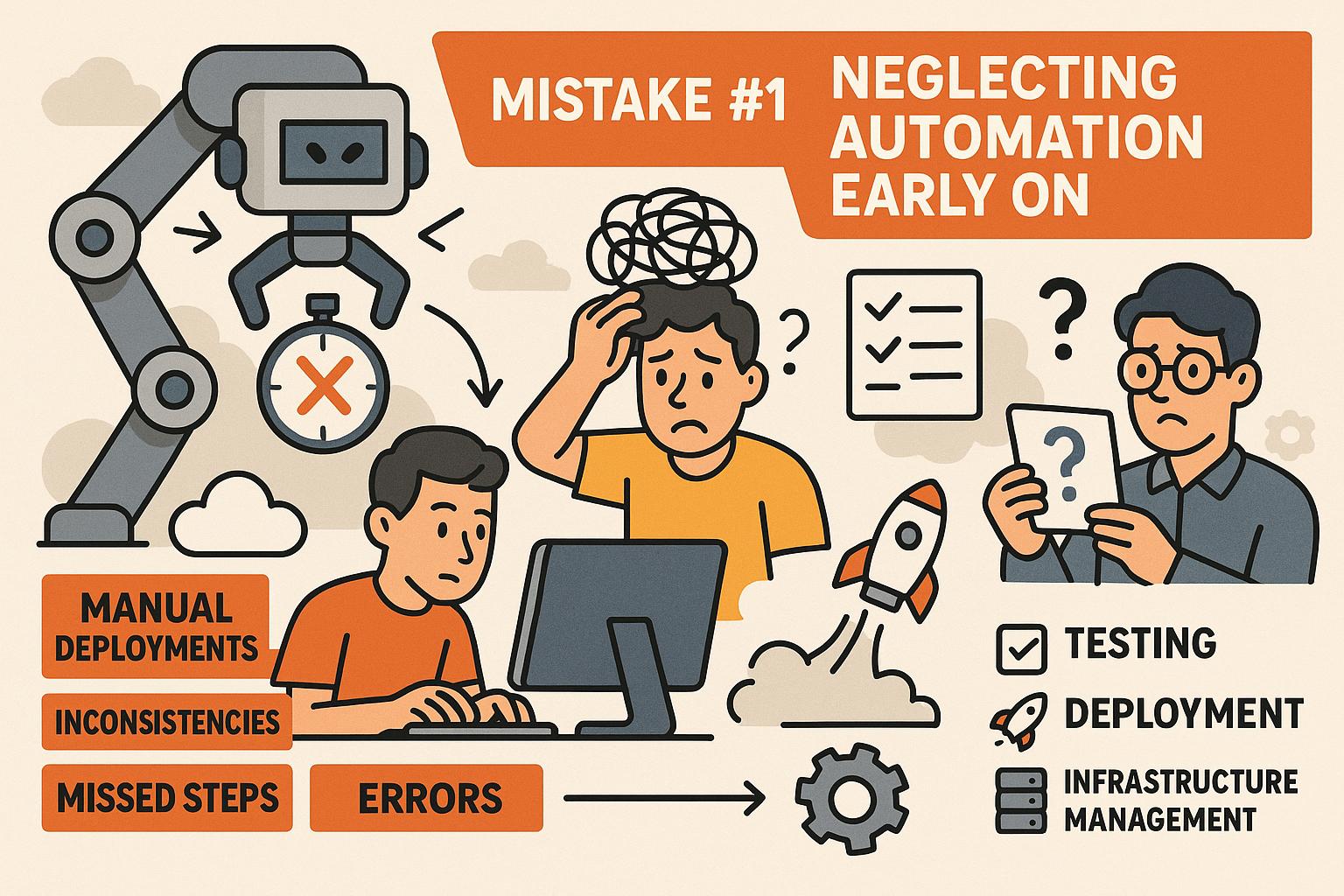
Skipping automation in the initial stages creates manual bottlenecks that compound as the team grows. Founders often assume they’ll have time to circle back and automate repetitive tasks, but that rarely happens without pain.
Manual deployments and one-off scripts seem like quick fixes, but they introduce inconsistencies, missed steps, and error-prone processes. Documentation lags behind, knowledge becomes tribal, and onboarding new engineers turns into a series of custom instructions no one fully trusts.
This leads to confusion and failed deployments when deadlines loom. Without version-controlled pipelines and infrastructure-as-code, rollback during outages becomes guesswork.
Early automation, even if rudimentary, saves hours later and builds habits around reproducibility. Teams that automate:
- Testing
- Deployment
- Infrastructure management
can iterate faster and restore services quickly after incidents.
Automation in CI/CD pipelines also forces teams to codify best practices. For Series A startups, leaving automation as an afterthought delays progress and exposes them to unforced errors.
Mistake #2: Overlooking Security in the DevOps Pipeline
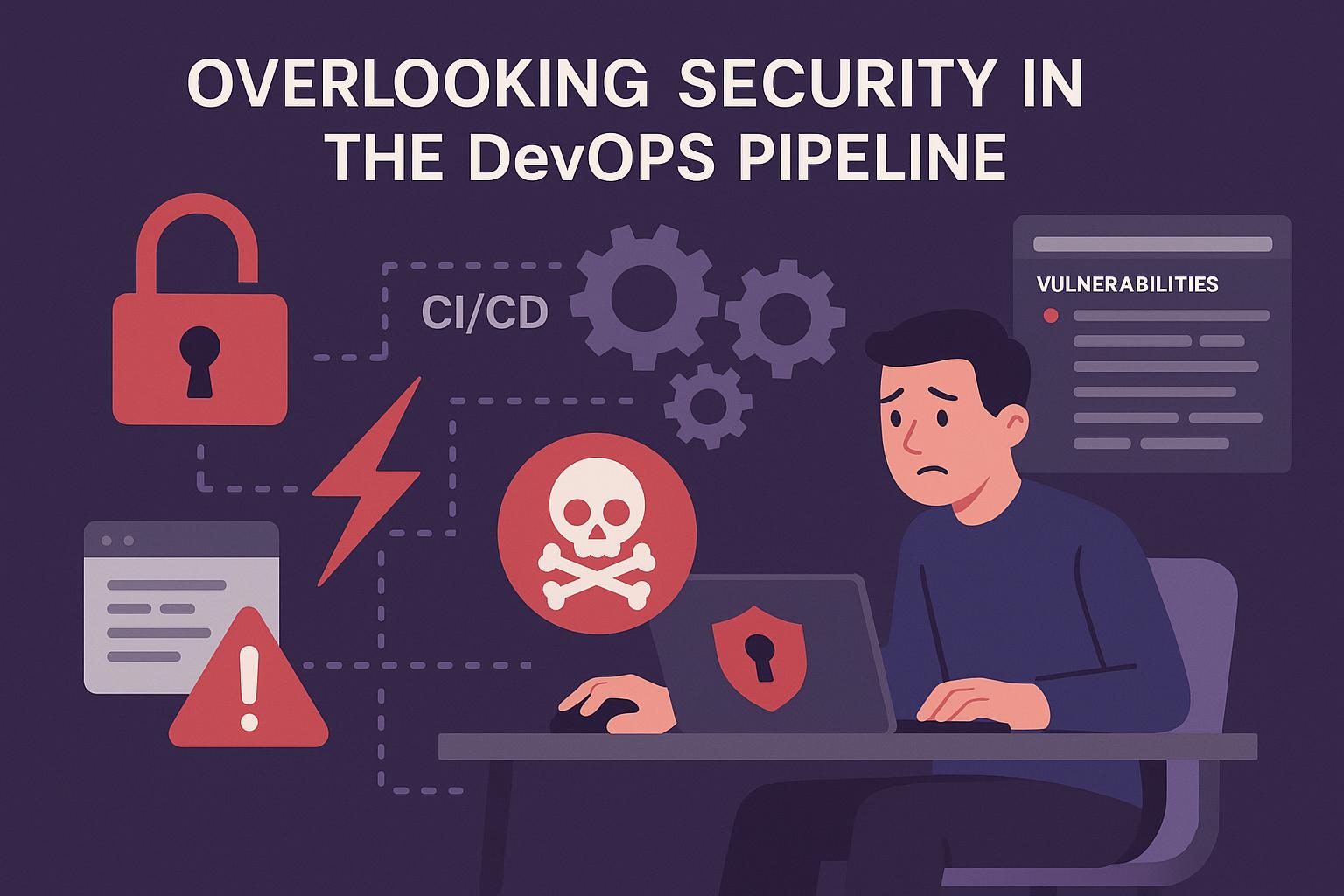
Ignoring security in the DevOps pipeline puts a startup at risk for data breaches and regulatory issues right out of the gate. Many teams rush to deliver features, assuming security costs too much time or money at this stage.
Relying on last-minute security checks or manual reviews doesn’t scale and usually fails. Simple missteps, like storing secrets in source code or skipping vulnerability scans, create weak points in critical systems.
Series A startups often lack a dedicated security hire, but integrating automated security testing into CI/CD is both feasible and essential.
When developers push code without automated static analysis or dependency scanning in place, vulnerabilities creep in unnoticed and become harder to fix later.
Teams need to treat security as part of their workflow, not as a separate function or afterthought.
- Early investment in these areas pays off:
- Secure pipelines
- Credential management
- Role-based access
This early commitment proves valuable when the product faces its first real-world attack or compliance audit. Ignoring this reality is costly.
Mistake #3: Failing to Foster a Collaborative Culture
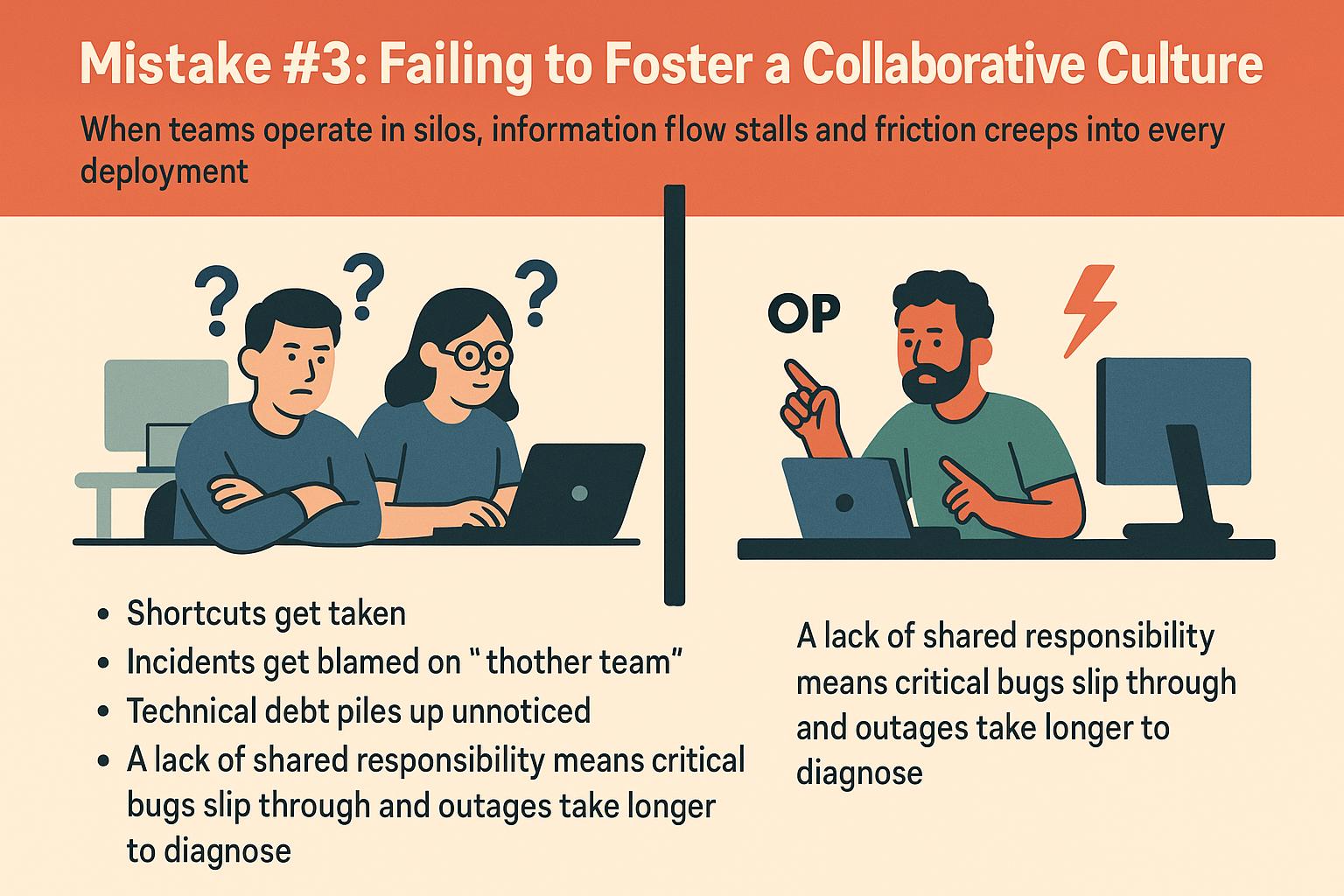
When teams operate in silos, information flow stalls and friction creeps into every deployment.
Series A startups often split engineers into isolated backend, frontend, or ops groups, which slows issue resolution and breeds finger-pointing when something breaks.
This gap widens as headcount grows, making it harder to coordinate, debug, or prioritize work.
When developers and operations don’t communicate regularly, knowledge around deployment practices, architectural changes, and system limitations remains fragmented.
- Shortcuts get taken
- Incidents get blamed on the “other team”
- Technical debt piles up unnoticed
A lack of shared responsibility means critical bugs slip through and outages take longer to diagnose.
Startups that invest early in creating open channels, shared dashboards, and post-incident reviews see fewer surprises.
Ownership of both success and failure, along with regular cross-functional meetings, helps catch hidden dependencies and uncovers issues faster.
Collaboration isn’t just about harmony—it’s the foundation for building resilient systems and maintaining rapid delivery speeds.
Mistake #4: Underestimating the Importance of Monitoring
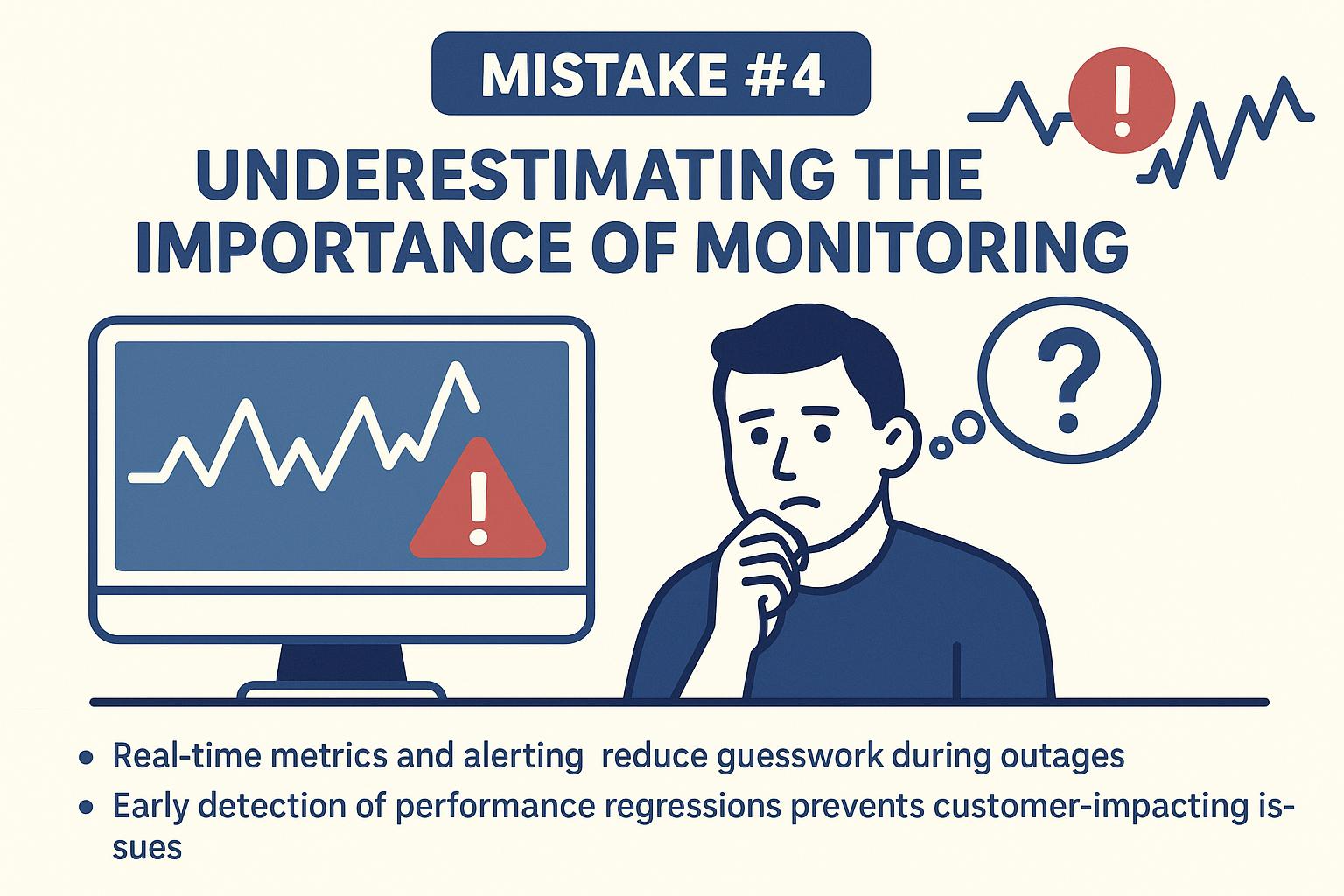
Skipping systematic monitoring is a common misstep among Series A teams focused solely on feature output. Many assume that setting up basic logging is enough to catch failures, but inadequate visibility leaves blind spots that quickly become costly.
When issues arise, the absence of real-time metrics and alerting forces teams to rely on guesswork, prolonging outages and masking underlying problems. Teams without structured monitoring are unable to detect subtle performance regressions or predict sudden capacity bottlenecks.
Feedback about user experience and system health is delayed until customers complain—damage that could have been prevented with early detection.
Key reasons why basic monitoring is not enough:
- Real-time metrics and alerting reduce guesswork during outages
- Early detection of performance regressions prevents customer-impacting issues
Establishing robust monitoring requires more than just collecting data; it demands clear alert thresholds and actionable dashboards that surface patterns before they impact production.
Relying on post-mortem analysis rather than live insights sets startups back, often turning minor bugs into crises. Early attention to monitoring grants teams the insight needed to proactively maintain reliability as they scale.
Mistake #5: Scaling DevOps Processes Too Late
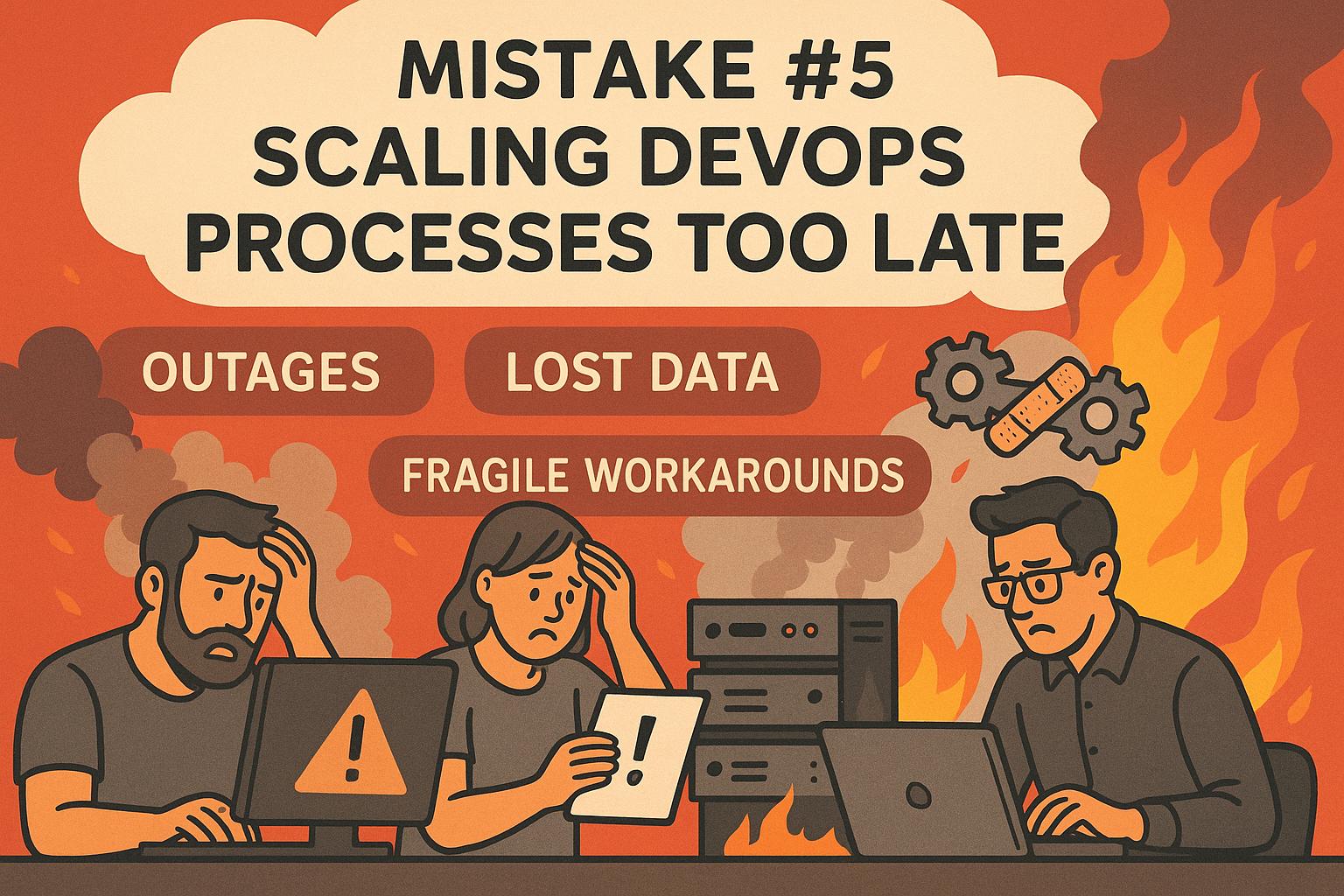
Series A startups often delay evolving their DevOps processes until scale forces their hand. By then, patchwork solutions and manual processes are deeply embedded, making transition efforts painful and disruptive.
Many teams believe they can retrofit scalability after gaining more users or revenue, only to hit roadblocks as technical debt accumulates. Fundamental gaps in CI/CD practices, infrastructure provisioning, or incident management cannot be addressed overnight.
Attempts to implement change during a crunch period usually result in:
- Outages
- Lost data
- Fragile workarounds
Startups waiting too long to standardize deployment flows, introduce configuration management, or separate staging from production environments take on unnecessary risk with each release. Code freezes become the norm when firefighting overwhelms the team.
Those who scale processes only when absolutely necessary typically experience missed SLAs and deferred feature launches. Building adaptable pipelines and flexible infrastructure early means fewer urgent fixes and less wasted engineering effort down the line.
Conclusion
Series A startups often stumble by treating DevOps as a set of isolated technical tasks rather than as the strategic backbone of their business. When manual workarounds are allowed, early security benchmarks are dismissed, and open communication is neglected, operational inefficiencies take root, hampering progress at every turn.
Monitoring should not be viewed as just another technical checkbox—it acts as the early warning system that keeps teams out of constant firefighting. Similarly, deferring process improvements until faced with growth pressures only turns manageable risks into crises that threaten stability and productivity.
Most of these recurring mistakes stem from viewing DevOps as an after-hours chore instead of a necessary, integral discipline. Early diligence pays significant dividends; shortcuts and delayed investments in best practices consistently lead to higher costs and greater headaches down the line.
This is precisely where solutions from modul8 bring significant value. By providing a flexible, integrated DevOps platform, modul8 helps startups establish concrete habits around automation, proactive security, and transparent collaboration from the very beginning. Its comprehensive tools support consistent monitoring, simplified deployment flows, and scalable infrastructure management—allowing technical teams to focus on building features rather than patching processes.
By hiring modul8, startups can proactively prevent repeated pain, build organizational credibility, and preserve their most limited resources. Teams that adopt modul8 and avoid the common pitfalls will have the operational flexibility and reliability needed to support their business at every stage of growth.

